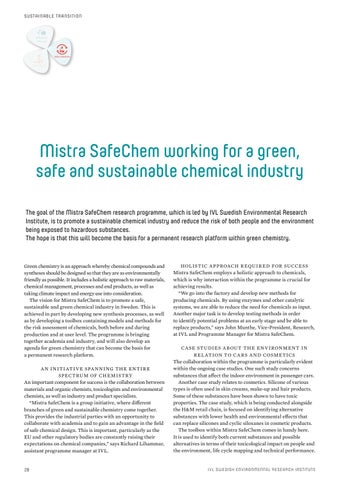S USTA I NABLE T R ANSI TION
Mistra SafeChem working for a green, safe and sustainable chemical industry The goal of the Mistra SafeChem research programme, which is led by IVL Swedish Environmental Research Institute, is to promote a sustainable chemical industry and reduce the risk of both people and the environment being exposed to hazardous substances. The hope is that this will become the basis for a permanent research platform within green chemistry.
Green chemistry is an approach whereby chemical compounds and syntheses should be designed so that they are as environmentally friendly as possible. It includes a holistic approach to raw materials, chemical management, processes and end products, as well as taking climate impact and energy use into consideration. The vision for Mistra SafeChem is to promote a safe, sustainable and green chemical industry in Sweden. This is achieved in part by developing new synthesis processes, as well as by developing a toolbox containing models and methods for the risk assessment of chemicals, both before and during production and at user level. The programme is bringing together academia and industry, and will also develop an agenda for green chemistry that can become the basis for a permanent research platform. A N I N IT I AT I V E SPA N N I NG T H E EN T I R E SPE CT RU M OF CH EM IST RY
An important component for success is the collaboration between materials and organic chemists, toxicologists and environmental chemists, as well as industry and product specialists. “Mistra SafeChem is a group initiative, where different branches of green and sustainable chemistry come together. This provides the industrial parties with an opportunity to collaborate with academia and to gain an advantage in the field of safe chemical design. This is important, particularly as the EU and other regulatory bodies are constantly raising their expectations on chemical companies,” says Richard Lihammar, assistant programme manager at IVL. 28
HOL IST IC A PPROACH R E QU I R E D F OR SUCCE S S
Mistra SafeChem employs a holistic approach to chemicals, which is why interaction within the programme is crucial for achieving results. “We go into the factory and develop new methods for producing chemicals. By using enzymes and other catalytic systems, we are able to reduce the need for chemicals as input. Another major task is to develop testing methods in order to identify potential problems at an early stage and be able to replace products,” says John Munthe, Vice-President, Research, at IVL and Programme Manager for Mistra SafeChem. C A SE ST U DI E S A BOU T T H E EN V I RON M EN T I N R E L AT ION T O C A R S A N D COSM ET ICS
The collaboration within the programme is particularly evident within the ongoing case studies. One such study concerns substances that affect the indoor environment in passenger cars. Another case study relates to cosmetics. Silicone of various types is often used in skin creams, make-up and hair products. Some of these substances have been shown to have toxic properties. The case study, which is being conducted alongside the H&M retail chain, is focused on identifying alternative substances with lower health and environmental effects that can replace silicones and cyclic siloxanes in cosmetic products. The toolbox within Mistra SafeChem comes in handy here. It is used to identify both current substances and possible alternatives in terms of their toxicological impact on people and the environment, life cycle mapping and technical performance.
IVL SWEDISH ENVIRONMENTAL RESEARCH INSTITUTE



























